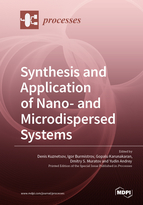Synthesis and Application of Nano- and Microdispersed Systems
A special issue of Processes (ISSN 2227-9717). This special issue belongs to the section "Materials Processes".
Deadline for manuscript submissions: closed (15 November 2020) | Viewed by 31479
Special Issue Editors
Interests: nanotmaterials; nanotechnologies; high-temperature materials
Special Issues, Collections and Topics in MDPI journals
Interests: composites; nanocomposites; conductive composites; potassium titanates; thermo-electrochemical cells; waste heat harvesting
Special Issues, Collections and Topics in MDPI journals
Interests: nanobiotechnology; materials science and technology; advanced materials
Special Issues, Collections and Topics in MDPI journals
Interests: nanomaterials; 2D materials; molecular spectroscopy; photovoltaics
Special Issue Information
Dear Colleagues,
Nano- and microdispersed systems can be defined as dispersions of nano- and microparticles (droplets, bubbles) of one material within a continuous phase of another material (gas, liquid, solid). Such systems are very widespread in nature. The most common examples include soils, aerosols, minerals, and various natural colloids. Nano- and microdispersed systems are also the subject of active research and represent a techno-economic sector with full expansion in many application domains. Nano- and microdispersed systems have gained prominence in technological advancements due to their diverse physicochemical and mechanical properties, including wettability, dispersion stability, electrical and thermal conductivity, catalytic activity, resulting in enhanced performance over their counterparts with particle size above 1 µm. Such systems are of interest to various research areas, including the development of new polymers and ceramic composites, sensors, biomaterials, energy conversion devices, wastewater treatment strategies, and many other applications.
The present Special Issue of Processes will include recent enhancements in the synthesis and application of various types of nano- and microdispersed systems and will help to expand scientific cooperation in this important field of research.
Dr. Denis Kuznetsov
Dr. Igor Burmistrov
Dr. Gopalu Karunakaran
Dr. Dmitry S. Muratov
Dr. Yudin Andrey
Guest Editors
Manuscript Submission Information
Manuscripts should be submitted online at www.mdpi.com by registering and logging in to this website. Once you are registered, click here to go to the submission form. Manuscripts can be submitted until the deadline. All submissions that pass pre-check are peer-reviewed. Accepted papers will be published continuously in the journal (as soon as accepted) and will be listed together on the special issue website. Research articles, review articles as well as short communications are invited. For planned papers, a title and short abstract (about 100 words) can be sent to the Editorial Office for announcement on this website.
Submitted manuscripts should not have been published previously, nor be under consideration for publication elsewhere (except conference proceedings papers). All manuscripts are thoroughly refereed through a single-blind peer-review process. A guide for authors and other relevant information for submission of manuscripts is available on the Instructions for Authors page. Processes is an international peer-reviewed open access monthly journal published by MDPI.
Please visit the Instructions for Authors page before submitting a manuscript. The Article Processing Charge (APC) for publication in this open access journal is 2400 CHF (Swiss Francs). Submitted papers should be well formatted and use good English. Authors may use MDPI's English editing service prior to publication or during author revisions.
Keywords
- Nanosystem
- Nanopowder
- Micropowders
- Nanomaterial
- Particle
- Powder
- Emulsion
- Colloid
- Aerosol
- Synthesis
- Application
- Process










